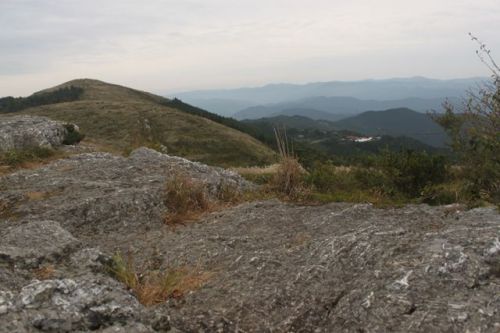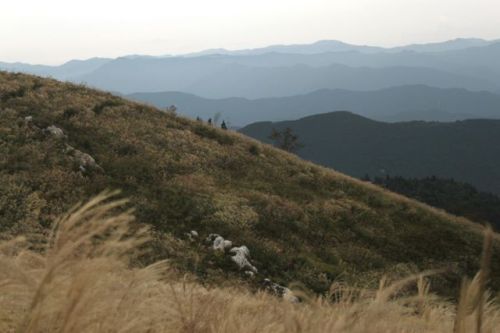Faced with a long 10km approach from the nearest bus stop, I knew that timing was of the essence if I wanted to make it off the mountain before dusk. So began another arduous journey into Wakayama prefecture to climb Mt. Oishi (生石) – the mountain of raw stone.

I took the fast train down to Kainan city on an overcast morning in early October. At the station, the micro-sized Orange bus awaited to shuttle passengers to a bus stop appropriately named tozanguchi. My map indicated that I only need to walk along the main road for about 5 kilometers until reaching the start of the hike, but the taxi office located adjacent to the bus terminal was too much to pass up. I hopped in an available cab and was happily ferried up to the fork in the road that marked the start of the traditional route up the once-sacred mountain. The road, in fact, continues on all the way to the top, but I was more interested in what the slopes had to offer than what lay on the desecrated summit.

Once out of the taxi, a metal signpost indicated that it was only a 6.5km stroll along the hiking trail to the top. Still, it beat the 11km walk in from the bus terminus. The path initially shared frontage with the paved road before climbing through a thicket of trees towards Daikanji temple. The temple itself was once along the Koya-nishi kaido, an ancient pilgrimage route to Koyasan that Shingon worshipers once tramped on their way to pay homage to Kobo Daishi. The sacred space now sits on the edge of a paved forest road overlooking fields dotted with cosmos, red spider lilies, and freshly harvested rice stalks hung on wooden racks to dry in the sun.

The route once again ran parallel with the pavement before yet again ducking into the forest and alongside a couple of jizo statues that led to an enormous evergreen oak tree (シラカシ) that is estimated to be over 350 years old. I gazed up at the towering hulk of wood, wondering if the seed was transplanted here naturally or if a zealous monk left it there as a memento to future generations.

After passing by a small mountain stream, the forest turned into monocultural cedar as I pushed my way towards the summit plateau. After an hour or so the angle did start to ease, and the first signs of civilization soon came into view. The route once again joined with the asphalt, skirting the edge of a mountain hut that probably last saw use during the Nixon administration. You’ll come across these abandoned structures all across Japan, the landowners too stingy to bother with the demolition costs and instead let nature run its course.

Just beyond this forlorn symbol of economic prosperity gone amiss, the trail terminated at the edge of an immense field of susuki grass stretching across the entire horizon. I had reached the entrance to Oishi plateau, and luckily this weekday morning it was relatively quiet. I shuttered to think about the zoo that this area must become during any weekend in autumn, when day trippers in their luxury automobiles invade the peak for a glimpse of the golden grasses.

The first thing to catch my eye was a rustic rest hut with the name Mountain Home (山の家). I stowed my pack on a bench and sifted through my coin purse for change to insert into the vending machine. Just moments later, a bowl of hot noodles and freshly made coffee made their way to my wooden table. They were just what I needed after the chill of the autumn air lowered my core temperature by a few degrees. Once thermal equilibrium was restored, it was time to see what these highlands had to offer.

I stepped outside, immediately drawn to a bulky granite outcrop sitting at the top of a gentle rise. Marked by a small shrine, the rock formation was easy to scale, affording unobstructed panoramic mountain views of the peaks of Koyasan and other unknown mountains nestled deep in Wakayama prefecture. After taking in the vistas, I meandered through the susuki grass like a pupil on a school outing – there was literally dozens of different paths to choose from as they made their way up to the high point, which was reached in about half an hour.

I sprawled out in the large clearing, enjoying the soft feel of the grass against my bare arms while taking in the stellar views. There was no signpost on the summit, and the only indication that it was indeed the high point was the rectangular block of concrete protruding from a tuft of grass – the triangulation point.

After a quick bite from a rice ball, I ducked into the forest once again for a variation that would loop back to the bus stop. I had intended on giving Oishi shrine a visit, but a wrong turn meant that I’d have both a lot of backtracking and vertical elevation gain if I wanted to double back for a look, so I left it to the imagination.

Most of the descent was, regrettably, through a vast forest of planted cedar and cypress, but the path did alternate between forest and village, giving a welcome insight into the lives of these rural denizens. The highlight was passing through an orchard of sanshō pepper trees whose leaves had turned a golden hue. Once back at the fork in the road, I spied a forest road to my left that looked as if it would lead me back to the bus stop. On a hunch, I followed the path, marked at regular intervals by jizo statues and tattered stone engravings. I surmised that this must have been part of the original Koya-nishi kaido before falling into misuse. My deductions were confirmed a bit further up the route when passing by a small temple situated at the base of a large waterfall dropping over a contorted rock formation. Here, a statue of Fudo Myo-o kept watch over the sacred prayer space. The forest road did connect up with the bus stop, which took me back to Kainan station with plenty of daylight left to catch the slow train back to Osaka.

It was a monumental effort, but the long haul was worth it, on one of Kansai’s more noteworthy peaks.





